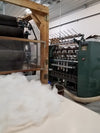early in the morning! Now that I've given you that ear worm.......
Your sheep are sheared and the wool is in waiting. Now what to do?
Back when I only had a few sheep, I would take pictures (with my camera, pre-cell and smart phones) of the fleece right on the skirting table. I would pull out a lock of wool and a lay it next to a ruler and snap another pic of the staple length. That's what the length of the fleece is called. Each fleece was numbered and that's how I would sell them online. I did well that way, but I am here to tell you, handspinners are a fickle lot. Their tastes and expectations run the gamut. I guess that's true with most things, but I grew weary and eventually shied away from selling raw fleeces. There are a lot of people out there who LOVE the process of taking a raw fleece from start to finished product. I am not one of them. Isn't it ironic that I now own a mill?
As soon as I heard there was a mill doing custom processing close to me, I was there. I started taking my wool to Thirteen Mile and handing it over to them to process into roving, batts and yarn. I settled into selling those products and an occasional raw fleece to past customers. Every time I delivered or picked up wool, Becky would ask me if I wanted to go to work there. Nope! Not me. Machines and I don't get along! Never say never, as they say.
Each mill is different. They have different machines that can handle different types of wool. Yes, each sheep breed is different and there can be many little different nuisances within the flock itself. That's the exciting part for people who love wool. If you're new to this sheep and wool thing, I suggest you shop around for the mill that fits your needs.
Here at the mill the wool is weighed in and labeled with the last name, which follows the wool throughout the entire process. Then it waits its turn in the washing rotation. Here at the Wool Mill, the wool goes through 4 washes and one rinse over the course of 5 days. Each tank of water is utilized to the max. The first to go in is the cleanest wool and it gets a rinse. The last to go in is raw wool. The wool is washed in HOT water. I know this comes as a surprise to a lot of people, but they have been misled by laundry tags and ads. You can wash wool in hot water. Any kind of wool. Just don't agitate it and be sure to rinse your item in the same temperature as the wash water it just came out of. I wash wool items often in my washing machine. The key points to remember are: I have a top-loading machine. I can start and stop at any time. Fill the washer with the hottest water possible, having added your detergent. Stop the washer and add your item. Let it soak. Again, DO NOT AGITATE. Agitation causes felt. I will often let things soak overnight and then hit the spin cycle in the morning. It's then ok to rinse in cold water. Again, rinse in the same temp you just spun out. You don't want to shock the wool. That can cause felting as well. It's important to get all of the soap out, so 2 rinses might be in order. Spinning is fine in the washing machine, just no agitation. I then lay my items out to dry on a towel. I can shape them that way. I have to cover them with another towel because my cats inevitably find them and will nap on them! Incidentally, I wash antique quilts the same way.
